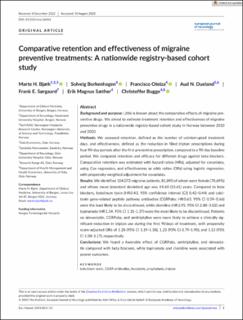Comparative retention and effectiveness of migraine preventive treatments: A nationwide registry-based cohort study
Bjørk, Marte-Helene; Borkenhagen, Solveig; Oteiza, Francisco; Dueland, Aud N.; Sørgaard, Frank E.; Sæther, Erik Magnus; Bugge, Christoffer
Journal article, Peer reviewed
Published version

Åpne
Permanent lenke
https://hdl.handle.net/11250/3111750Utgivelsesdato
2023Metadata
Vis full innførselSamlinger
- Department of Clinical Medicine [2066]
- Registrations from Cristin [9791]
Sammendrag
Background and purpose
Little is known about the comparative effects of migraine preventive drugs. We aimed to estimate treatment retention and effectiveness of migraine preventive drugs in a nationwide registry-based cohort study in Norway between 2010 and 2020.
Methods
We assessed retention, defined as the number of uninterrupted treatment days, and effectiveness, defined as the reduction in filled triptan prescriptions during four 90-day periods after the first preventive prescription, compared to a 90-day baseline period. We compared retention and efficacy for different drugs against beta blockers. Comparative retention was estimated with hazard ratios (HRs), adjusted for covariates, using Cox regression, and effectiveness as odds ratios (ORs) using logistic regression, with propensity-weighted adjustment for covariates.
Results
We identified 104,072 migraine patients, 81,890 of whom were female (78.69%) and whose mean (standard deviation) age was 44.60 (15.61) years. Compared to beta blockers, botulinum toxin (HR 0.43, 95% confidence interval [CI] 0.42–0.44) and calcitonin gene-related peptide pathway antibodies (CGRPabs; HR 0.63, 95% CI 0.59–0.66) were the least likely to be discontinued, while clonidine (HR 2.95, 95% CI 2.88–3.02) and topiramate (HR 1.34, 95% CI 1.31–1.37) were the most likely to be discontinued. Patients on simvastatin, CGRPabs, and amitriptyline were more likely to achieve a clinically significant reduction in triptan use during the first 90 days of treatment, with propensity score-adjusted ORs of 1.28 (95% CI 1.19–1.38), 1.23 (95% CI 0.79–1.90), and 1.13 (95% CI 1.08–1.17), respectively.
Conclusions
We found a favorable effect of CGRPabs, amitriptyline, and simvastatin compared with beta blockers, while topiramate and clonidine were associated with poorer outcomes.
